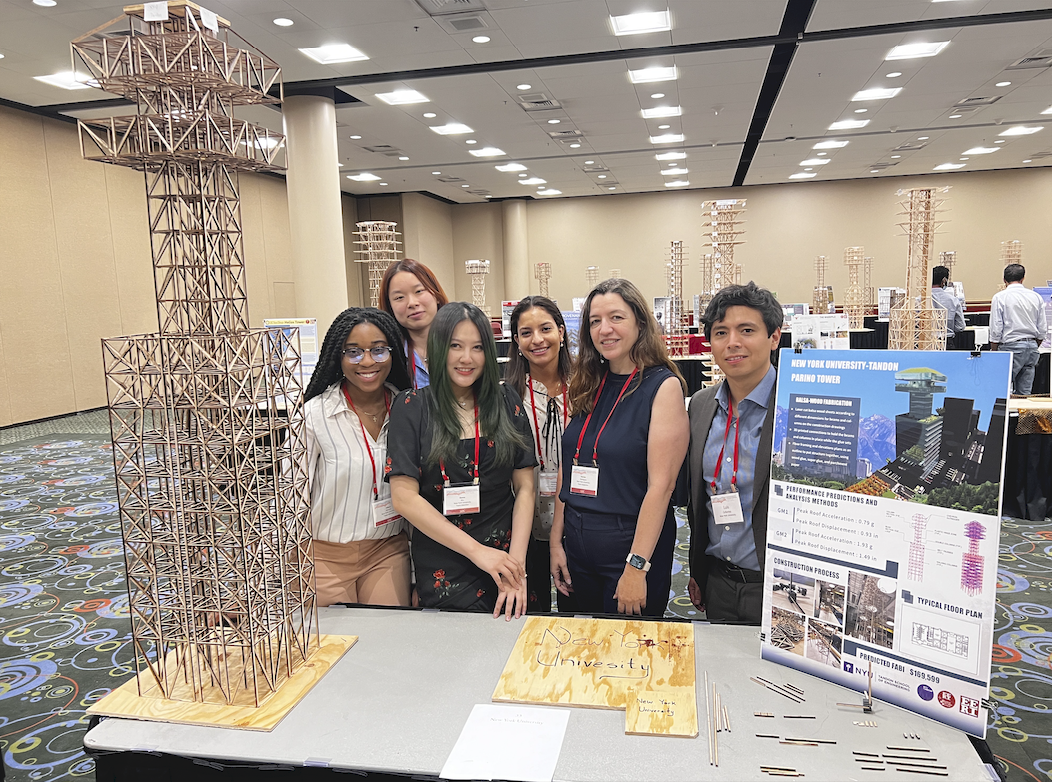A seismic performance
NYU Tandon team shook the competition at the Earthquake Engineering Research Institute seismic design competition

The NYU Tandon Seismic Design Team placed fifth among U.S. universities and 11th on the global stage at the 2022 EERI Seismic Design Competition
The Federal Emergency Management Agency estimates that earthquake losses in the U.S. add up to more than $4 billion dollars a year. Around the world, some 20,000 people are killed annually when tectonic plates in the Earth’s crust shift, and the resulting seismic waves wreak havoc.
NYU Tandon is helping educate the next generation of earthquake engineers — those able to analyze the potential consequences of strong earthquakes and design and build structures that can withstand seismic effects as effectively as possible.
This year, a group of students from the NYU Tandon Seismic Design Team took part in the Earthquake Engineering Research Institute’s Annual Undergraduate Seismic Design Competition. Held in conjunction with the 2022 National Conference of Earthquake Engineering, in Salt Lake City, Utah, the competition presented teams with a scenario:
Straddling the intermountain seismic belt between the Great Basin and the Rocky Mountains, Salt Lake City frequently experiences earthquakes. Of great concern is that two individual faults — the Warm Springs fault and East Bench fault — are connected to one another directly under downtown Salt Lake City, and Utah Geological Survey’s research has predicted that there is a 16.5 percent chance that one of the area’s faults will cause a major earthquake within the next century.
Given the challenges posed by the seismicity of the area, your hypothetical company has been tasked with constructing a new building in the downtown area. The architect has a unique vision that must be met, the city’s building council is encouraging the incorporation of sustainable and energy-efficient features, and Salt Lake City’s complex geological setting must be taken into consideration.
Students were charged with creating a scaled balsa wood model of their proposed building design using laser cutting and 3D printing, and bringing it to the competition, where it would be subjected to intensive testing on the shake table.
“It’s not enough to simply design a structure that won’t collapse,” team captain Danna Wu explained. “The building must continue to function as well as possible, so the design took a more holistic approach, because factors such as how much the structure accelerate and deforms, or drifts, — which is a measurement of the sideways deflection of one floor relative to the sideways deflection of another — can make the difference between manageable and catastrophic damage.”
Judges also conducted a cost-benefit analysis that balanced the possible revenue generated by the building with its initial cost and seismic cost (the economic loss estimated to occur during an earthquake).
The fledgling Tandon team successfully met with a few challenges even before arriving in Utah — not the least of which involved getting a five-foot-tall model through airport security and onto a plane. Doing so required breaking it down into parts, building a custom container, and classifying it as oversized luggage, but their creation made it to Salt Lake City with only minor damage.
With just three members arriving early in Utah, the team spent two sleepless nights making sure their model was competition ready, and that work ultimately paid off: Despite being at their very first in-person competition–and despite going head-to-head with teams comprising dozens of students — NYU Tandon landed in fifth place among U.S. universities and 11th on the global stage against schools in Romania, Indonesia, Egypt, Canada, and elsewhere.
“It was a great experience for the students; they not only got the chance to work in the MakerSpace, build something very cool, and travel to the competition but were able to network with professionals and hear scholarly presentations at the EERI Conference,” said Assistant Professor of Civil and Urban Engineering Luis Ceferino, who advised the group. “They tackled some very difficult but exciting tasks in the course of the project, and I hope even more students consider joining next year’s team to pitch in.”
Wu, who recently graduated with a B.S. in Civil Engineering, found the experience to be one of the most gratifying of her time at Tandon. “We didn’t just build a sound structural model,” she said. “We built a cohesive team, and that ability will serve us well no matter where our careers take us.”
For more information on the Seismic Design Team, contact EERITandon@gmail.com or follow and message them on Instagram @nyueeritandon.

Faculty and Staff Supporters:
- Professor Luis Ceferino (Advisor)
- Professor Patricia Rodriguez (Advisor)
- Professor Jose Ulerio
- Proffesor Magued Iskander
- Tricia Chang
- Andreas Karpf
- Sebastian Bellantuono
- Elizabeth New (NYU Makerspace)
- James Um (VIP Program)
Graduate and Alumni Mentors:
- Prateek Arora
- Zobee Ali
- Sophia Mercurio
Core Team Members:
- Danna Wu (Design Captain)
- Hillary Abordo
- Athar Abdullah
- Lin Lin Jin
- Omar Abdelsalam
- Arye Ludmir
- Emmalyn Romero
Other Students:
- Yanely Jean-Louis
- Ayesha Bhutta
- Richard Liu
- Marisa Searle
- Ata Cetin

